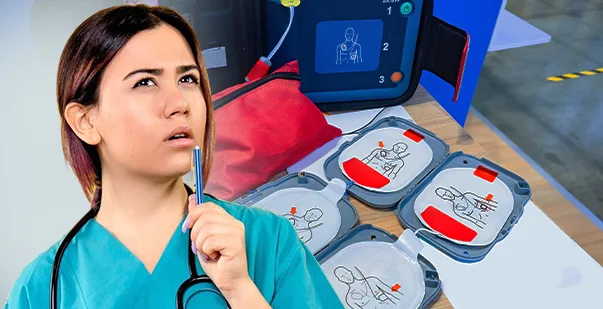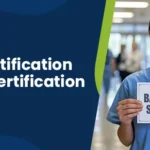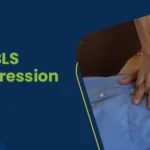Table of Contents:
- Introduction
- What is Sudden Cardiac Arrest (SCA)?
- What is a Defibrillator?
- How does an AED work?
- What Are ICDs?
- Misconceptions of Defibrillators
- AED Maintenance and Readiness
- Wrapping Up
Introduction
Emergencies can happen anywhere and at any time, so it’s important to be prepared to help when needed. Imagine you’re at a park or in a busy store when someone suddenly goes into a cardiac arrest. In these critical moments, knowing how to use an Automated External Defibrillator (AED) can help save a life.
AEDs are user-friendly machines that deliver a shock to the heart, helping it return to its normal rhythm. They guide you through each step with clear voice instructions so that you can act quickly and confidently in an emergency.
In this guide, we’ll explain what a defibrillator is used for and how an AED works. We’ll break down the steps from turning on the device to delivering a shock and explain how to use it alongside CPR to give someone the best chance of survival.
Master ACLS Now
Get ACLS certified with confidence
What is Sudden Cardiac Arrest (SCA)?
Sudden cardiac arrest (SCA) occurs when the heart suddenly stops beating and ceases to pump blood. Blood is circulated throughout your body by the heart. Blood carries oxygen, which is essential for survival. Blood flow to the brain, lungs, and other organs is interrupted when the heart stops working. A person can die within minutes without oxygen and hence this is a very serious condition.
Now that we know what sudden cardiac arrest is, let’s explore what the defibrillator is used for and how it can help save someone during cardiac arrest.
Read More: BLS certification program
What is a Defibrillator?
Defibrillator is A device used to treat ventricular fibrillation, a dangerous heart condition in which the heart quivers instead of beating normally., is called a defibrillator. To correct this, a defibrillator sends a short burst of electricity through the heart. This shock helps the heart’s natural pacemaker regain control and restore a regular rhythm.
The defibrillator uses two electrodes to deliver the electrical current to the heart. These electrodes can be either metal paddles or adhesive pads. A special gel is used with the electrodes to reduce the body’s natural resistance to electricity and prevent burns from the shock. The gel ensures that the current flows smoothly through the body.
The types of defibrillators are:
-
Manual Defibrillators
These devices require professional training to use and are commonly found in hospitals. They allow the operator to diagnose the heart rhythm and manually set the shock’s voltage and duration. Metal paddles are typically used with these devices.
-
Automated External Defibrillators (AEDs)
AEDs are user-friendly and can be found in public places like schools and airports. The device automatically detects if the heart needs a shock and will not deliver one unless necessary. This makes it safe for use by anyone, even without medical training.
-
Internal Defibrillators
Internal defibrillators can be surgically implanted in the body for patients at high risk. These devices constantly monitor the heart’s rhythm and automatically deliver a shock if needed. Wearable models are also available for patients who don’t require a permanent implant.
Read More: Ventricular Fibrillation: Causes, Symptoms, and Treatment
Master ACLS Now
Get ACLS certified with confidence
How Does an AED Work?
Studies have shown that using an AED within the first few minutes of cardiac arrest can increase survival rates by up to 70%. Here’s a simple guide on how an AED works:
-
Turning on the AED
When you first encounter someone who may be experiencing sudden cardiac arrest, the first step is to turn on the AED. This is usually done by pressing a power button or lifting the device’s lid. Once the AED is turned on, it will start giving you clear, step-by-step voice instructions. Some AEDs also have visual prompts, such as flashing lights or text displays, to guide you through the process.
-
Attaching the Pads
The next step is to attach the AED pads to the person’s bare chest. The AED comes with two adhesive pads, also known as electrodes. The pads may have pictures or diagrams on them to help you place them correctly. One pad should be placed just below the collarbone, on the upper right side of the chest, and the other on the lower left side of the chest, a few inches below the armpit.
-
Analyzing the Heart’s Rhythm
Once the pads are correctly placed, the AED will automatically analyze the person’s heart rhythm. During this time, it is important not to touch the person, as this can interfere with the device’s analysis. The AED will quickly determine whether the person needs a shock to restore their heart’s normal rhythm. If the AED detects a rhythm that can be treated with a shock, it will prepare to deliver one.
-
Delivering the Shock
The AED will instruct you to press a button that delivers shock to the victim if it is required. Some AEDs deliver the shock automatically. Before pressing the button, make sure that no one, including yourself, is touching the person. The shock is intended to stop the abnormal heart rhythm, allowing the heart to restart with a normal rhythm. This process is called defibrillation. After delivering the shock, the AED will re-analyze the heart’s rhythm to see if another shock is needed or if the heart has returned to a normal rhythm.
-
Providing CPR
If the AED instructs you to do so, begin providing CPR (cardiopulmonary resuscitation). CPR involves chest compressions and rescue breaths to help keep blood flowing to the brain and other vital organs. The AED may give you instructions on how to perform CPR, including how deep and fast to push on the chest. Continue following the AED’s instructions until emergency medical services (EMS) arrive or the person shows signs of recovery, such as breathing normally or moving.
Read More: Everything you need to know about ACLS
What Are ICDs?
An Implantable Cardioverter-Defibrillator (ICD) is a small device implanted in the chest to help people who are at high risk of sudden cardiac arrest. The ICD continuously monitors the heart’s rhythm and can deliver an electric shock if it detects a dangerous irregularity.
ICDs are typically recommended for people who have survived a cardiac arrest or have a history of severe heart rhythm problems. They are also used for those with certain heart conditions that put them at high risk of sudden cardiac arrest. Here’s how ICDs work:
- Monitoring: The ICD constantly keeps track of the heart’s rhythm.
- Pacing: If the heart beats too slowly, the ICD can act like a pacemaker and send small electrical impulses to correct the rhythm.
- Cardioversion: If the heart beats too fast or irregularly, the ICD can send a mild shock to restore a normal rhythm.
- Defibrillation: If the heart enters a life-threatening rhythm, the ICD delivers a stronger shock to reset the heart and restore a regular beat.
Types of ICDs
Implantable Cardioverter-Defibrillators (ICDs) come in different types to meet the specific needs of patients at risk of life-threatening heart rhythms. Here’s a simple breakdown of the main types:
- Single-Chamber ICDs: This type of ICD has one lead (a thin wire) that connects to a single chamber of the heart, usually the right ventricle. It’s typically used for patients who need pacing or defibrillation in just one chamber of the heart. It monitors the heart rhythm and delivers shocks when necessary.
- Dual-Chamber ICDs: Dual-chamber ICDs have two leads—one placed in the right atrium and the other in the right ventricle. These are used for patients who need to monitor and pace both the upper and lower chambers of the heart. They help coordinate the timing of the heart’s contractions, providing more precise rhythm control.
- Biventricular ICDs (CRT-Ds): Biventricular ICDs, also known as Cardiac Resynchronization Therapy Defibrillators (CRT-Ds), have three leads placed in the right atrium, right ventricle, and left ventricle. This type is for patients with heart failure and a specific type of abnormal heart rhythm. It helps both ventricles beat in sync, improving the heart’s efficiency.
Misconceptions of Defibrillators
There are many misconceptions about defibrillators that can make people hesitant to use them in an emergency. Understanding the truth about how defibrillators work can help you feel more confident and prepared. Here are some common myths about defibrillators and the facts you need to know:
Myth 1: Defibrillators Restart a Stopped Heart
Many people think defibrillators restart a stopped heart, like in the movies. In reality, defibrillators correct irregular heartbeats. When the heart quivers (fibrillates) instead of beating properly, the defibrillator sends an electric shock to reset it. It doesn’t jump-start a heart that’s completely stopped.
Myth 2: Using a Defibrillator is Complicated
Some worry that using a defibrillator is too difficult or that it might make things worse. In truth, Automated External Defibrillators (AEDs) are designed to be simple and safe. They have clear voice instructions, and the machine decides if a shock is needed. You can’t accidentally shock someone who doesn’t need it.
Myth 3: You Need Special Training to Use a Defibrillator
While training helps, it’s not required to use an AED. The device is made for anyone to use in an emergency. The instructions guide you step by step, making it easy to help save a life.
Myth 4: Defibrillators Can Hurt the Person or the User
People fear that defibrillators can cause harm, but they are designed to be safe. The electric shock is controlled and only affects the heart, not the whole body. As long as you follow instructions and avoid touching the person during the shock, there’s no risk of injury.
Myth 5: AEDs aren’t Necessary if You Know CPR
CPR is vital, but it doesn’t fix the heart’s rhythm. A defibrillator is the only tool that can correct fibrillation. Using both CPR and a defibrillator together gives the best chance of saving a life.
In summary, defibrillators are easy to use, safe, and crucial in emergencies. Knowing the facts can help you act confidently if you ever need to use one.
AED Maintenance and Readiness
Maintaining an AED is crucial to ensuring it’s ready to use in an emergency. Proper upkeep and easy accessibility can make a significant difference in an emergency. Here’s how to maintain an AED:
- Regular Checks
It’s important to perform regular checks to ensure that an AED is ready to use in an emergency. Most AEDs have a status indicator that shows whether the device is functioning properly. Make sure the indicator shows that the AED is ready for use and that the battery and pads are not expired.
- Keeping it Accessible
An AED should always be kept in an easily accessible location. In public places, AEDs are often stored in clearly marked cabinets that are easy to find. Make sure everyone in your organization knows where the AED is located and how to access it quickly.
- Training and Refresher Courses
Even though AEDs are simple to use, it’s still a good idea to take a training course and participate in regular refresher courses. This ensures that you stay familiar with the device and feel confident using it in an emergency.
Wrapping Up
Understanding what a defibrillator is used for can empower you to act quickly and confidently in an emergency. Whether you’re at work, school, or simply out in public, knowing how to use an AED could save someone’s life.
Don’t let common misconceptions hold you back—using an AED is simpler than you might think, and it doesn’t require special skills. By pairing AED use with CPR, you’re giving someone the best possible chance of survival during sudden cardiac arrest.
So, take a moment to familiarize yourself with the AEDs in your environment, and consider getting trained, even if it’s not required. In an emergency, every second counts, and knowing how to respond can make all the difference. Find an ACLS class near you and get trained in AED use as quickly as possible.







